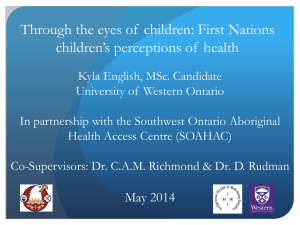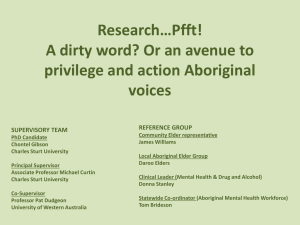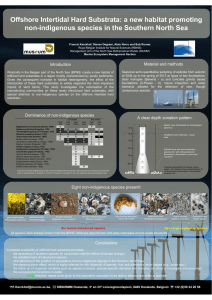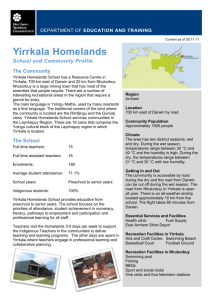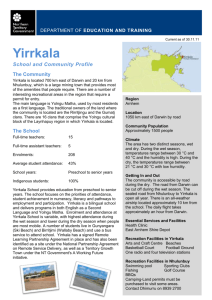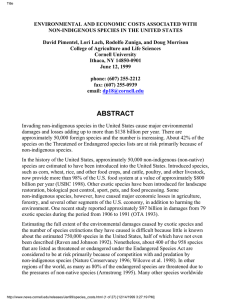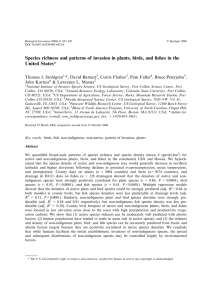aso reader`s notes
advertisement
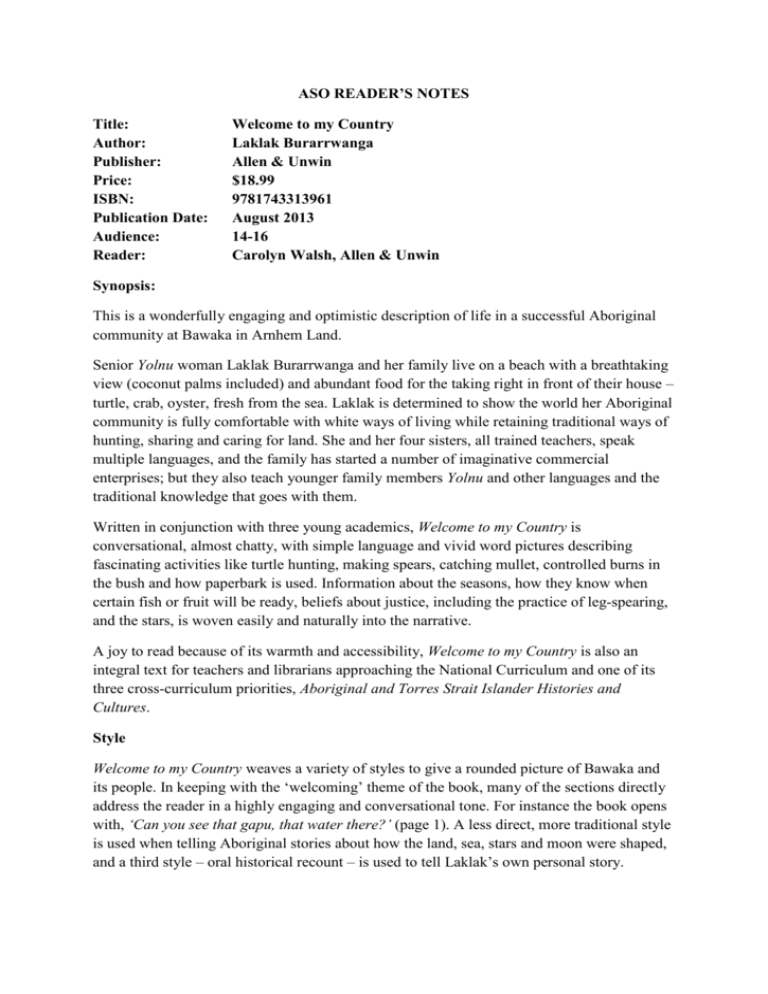
ASO READER’S NOTES Title: Author: Publisher: Price: ISBN: Publication Date: Audience: Reader: Welcome to my Country Laklak Burarrwanga Allen & Unwin $18.99 9781743313961 August 2013 14-16 Carolyn Walsh, Allen & Unwin Synopsis: This is a wonderfully engaging and optimistic description of life in a successful Aboriginal community at Bawaka in Arnhem Land. Senior Yolnu woman Laklak Burarrwanga and her family live on a beach with a breathtaking view (coconut palms included) and abundant food for the taking right in front of their house – turtle, crab, oyster, fresh from the sea. Laklak is determined to show the world her Aboriginal community is fully comfortable with white ways of living while retaining traditional ways of hunting, sharing and caring for land. She and her four sisters, all trained teachers, speak multiple languages, and the family has started a number of imaginative commercial enterprises; but they also teach younger family members Yolnu and other languages and the traditional knowledge that goes with them. Written in conjunction with three young academics, Welcome to my Country is conversational, almost chatty, with simple language and vivid word pictures describing fascinating activities like turtle hunting, making spears, catching mullet, controlled burns in the bush and how paperbark is used. Information about the seasons, how they know when certain fish or fruit will be ready, beliefs about justice, including the practice of leg-spearing, and the stars, is woven easily and naturally into the narrative. A joy to read because of its warmth and accessibility, Welcome to my Country is also an integral text for teachers and librarians approaching the National Curriculum and one of its three cross-curriculum priorities, Aboriginal and Torres Strait Islander Histories and Cultures. Style Welcome to my Country weaves a variety of styles to give a rounded picture of Bawaka and its people. In keeping with the ‘welcoming’ theme of the book, many of the sections directly address the reader in a highly engaging and conversational tone. For instance the book opens with, ‘Can you see that gapu, that water there?’ (page 1). A less direct, more traditional style is used when telling Aboriginal stories about how the land, sea, stars and moon were shaped, and a third style – oral historical recount – is used to tell Laklak’s own personal story. Interwoven are delightful breakouts explaining the structure of the language, counting system, sign language and bush food. A Yolnu word list is also provided – allowing the reader to come to terms with the sounds of the language and vocabulary and, as a result, become immersed in the culture on a deeper level. Interspersed with the text are beautiful colour photographs of Bawaka and its inhabitants, and pictures of Aboriginal artworks depicting some of the stories being told. Although so much of this book is warm and engaging, hopeful and optimistic, Welcome to my Country never shies away from some of the more tragic aspects of Indigenous history. It explains battles with mining companies, the fight for land rights, and the devastating effect of non-Indigenous influences to the culture, including alcohol. Author Motivation: Laklak Burarrwanga works tirelessly for her community and believes understanding between Indigenous and non-Indigenous cultures is something to strive for. ‘I have been doing lots of book writing, teaching, kids going through college, starting the business. Lots of non-Indigenous people are coming and learning our knowledge, our law. That’s what I see, the boy standing with the spear. That is the bush university, the real life, the land and nature. The other side of the world that I see is the boy sitting on a rock at Bawaka playing with a computer. This kid can see a wider world, learning through a computer. That’s the new generation, mixing the knowledges together. Then the boys can change over, boy with spear can play with computer and vice versa. ‘Now I work with Sarah, Kate and Sandie….Every year they come here to help me with my family so we can understand each other and make a unity – Indigenous and non-Indigenous to make a unity and friendship for the future.’ **** Dr Sarah White says of her collaboration with Laklak Burarrwanga, ‘At the launch of our first book towards the end of 2008 Laklak, her sisters Ritjilili, Dhalalu and Banbapuy, and her daughter Djawundil, told [me] that...they would like to write a book on Yolnu mathematics. Many tourists and visitors come to Bawaka and they comment on how beautiful it is but the sisters and Djawundil wanted these non-Indigenous people to understand that Yolnu people see a lot, lot more. That underneath that beauty are many, many layers of knowledge, connections, obligations, communications and understandings. So from mid-2009 [we … started] working with Laklak, her sisters and daughter and with Bawaka itself, collecting stories, songs, experiences, emotions for the book. We’ve worked together sitting under the casuarinas trees by the beach at Bawaka; we’ve worked together sitting in the garden of Laklak’s son in the nearest Aboriginal community of Yirrkala; we’ve written down stories told by Dhalalu at a Marae in New Zealand; we’ve eaten the miyapunu mapu and dug for the ganguri; we’ve put out fish for Nike the crocodile and sent our partners out hunting; we’ve clarified stories and agonised over spelling; chatted over crackly mobile phones and worked through other’s emails; we’ve laughed and cried; relaxed under the sunsets and ducked away from the thunder. ‘….We are all so very lucky to have come to know each other over the years and to be able to work together so well. We hope that others will also value the opportunity to get to know Bawaka and Laklak and her family through the book and that it will enrich peoples’ lives, understandings and ways of knowing themselves and their worlds.’ Author Background: Laklak is a Datiwuy Elder, Caretaker for Gumatj, and eldest sister. As a teacher in the community at Bawaka, she has spent decades sharing her knowledge with the children of her community, as well as writing and translating books for the Yirrkala Community School. Seven years ago she helped to establish her family-owned tourism business Bawaka Cultural Experiences (BCE) and is also a member of the Yothu Yindi Garma Foundation. Laklak Burarrwanga, Sarah Wright, Sandie Suchet-Pearson and Kate Lloyd are an Indigenous and non-Indigenous research collective. Laklak and her sisters are elders and caretakers for Bawaka Country in northeast Arnhem Land. Sarah, Sandie and Kate are three non-Indigenous academics from Newcastle and Macquarie universities. The group have worked together as a research collective since 2006, and have written two books and several academic and popular articles together. Suggestions for classroom discussion and application: A cross-curriculum priority of the Australian Curriculum is Aboriginal and Torres Strait Islander Histories and Cultures. Welcome to my Country is an invaluable text across a number of subject areas including; geography, history, Aboriginal studies, mathematics, and studies of religion. Before reading Welcome to my Country ask students to break into groups and research one of the following topics: Climate and geography of Arnhem Land Aboriginal rights pre-1960 (including citizenship and rights to land) the Gove land rights case Yirrkala bark petitions the development of the land rights movement Mabo and the Native Title Act. Have students present their research to the rest of the class in 3-5 minute talks, incorporating PowerPoint, music and images where appropriate. Introduce discussion of the concept of landscape to your class. Ask them how European cultures traditionally responded to the Australian landscape in terms of bushfires, floods and drought. Now ask students to break into small groups to discuss how Laklak Burarrwanga and her family relate to their landscape. Make sure students understand the concepts of yothu yindi and songlines. Follow this activity with a homework task where students write a 500 word essay explaining the Yolnu view. Extension question: ‘In the Yolnu world, we have a library in the land. You can’t destroy it. If you burn it, it grows again. The land is full of more knowledge than you can imagine.’ How does this attitude differ from traditional western conceptions of the Australian landscape? Counting exercise: explain that there isn’t just one form of counting in the world but that many societies have developed their own methods. While non-Indigenous Australians count using a decimal system, Yolnu is based on sets of five. Create a worksheet with simple mathematical questions, like those featured on page 35. Have students use the chart on page 34 to answer the questions. Extension question: What does the author mean when she writes that, ‘Spearing a fish takes great skill and an understanding of mathematics.’ (page 87)? Give students some time to learn the sign language for gurrutu that appears on page 167. In groups of two, have them practise it, with one student choosing a word and the other using the appropriate sign for that word. The authors say that Makarrata - the peace-making ceremony described on pp 82-85 – is no longer used by them and that they pass disagreements on to the police. Ask students to debate whether Makarrata should be permitted in Indigenous societies practising traditional values. On page 119, Laklak Burarrwanga writes, ‘Knowledge doesn’t just flow one way from napaki [non-Indigenous society] to us. We have knowledge too.’ Ask students to write an essay or create a digital presentation on the knowledge they have gained from reading Welcome to my Country. Introduce your students to the music of Yothu Yindi, who are from the Yolnu homelands near Yirrkala in Arnhem Land. Geoffrey Gurrumul Yunupingu is also Yolnu and you can find many clips of him singing solo or with artists such as Elton John, Missy Higgins, Sting and Sarah Blasko. Selling Points: Review copies of Welcome to my Country will be mailed broadly to relevant media. The book will be featured in mailings and newsletters to schools and is on the Allen & Unwin website. Welcome to my Country will be advertised in key children’s literature journals.








